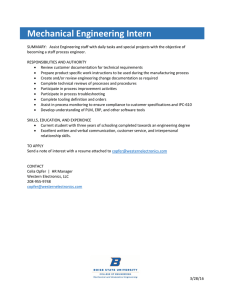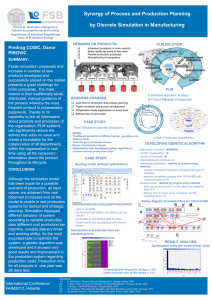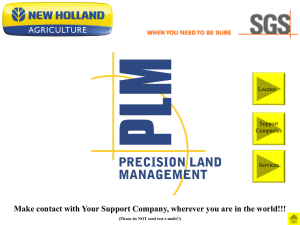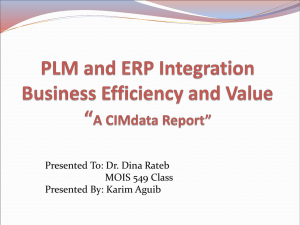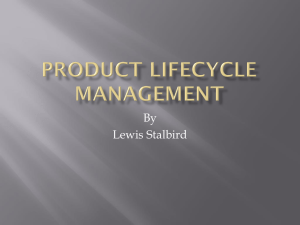gan and Teaching is about making some kind of dent in the...
advertisement
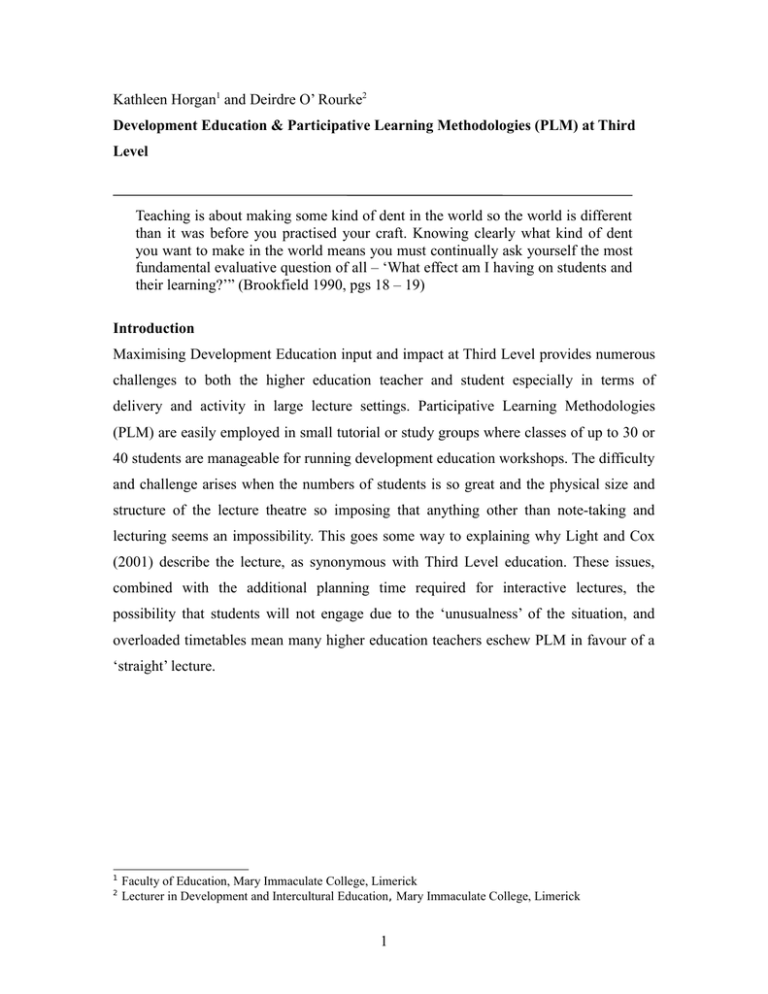
Kathleen Horgan1 and Deirdre O’ Rourke2 Development Education & Participative Learning Methodologies (PLM) at Third Level Teaching is about making some kind of dent in the world so the world is different than it was before you practised your craft. Knowing clearly what kind of dent you want to make in the world means you must continually ask yourself the most fundamental evaluative question of all – ‘What effect am I having on students and their learning?’” (Brookfield 1990, pgs 18 – 19) Introduction Maximising Development Education input and impact at Third Level provides numerous challenges to both the higher education teacher and student especially in terms of delivery and activity in large lecture settings. Participative Learning Methodologies (PLM) are easily employed in small tutorial or study groups where classes of up to 30 or 40 students are manageable for running development education workshops. The difficulty and challenge arises when the numbers of students is so great and the physical size and structure of the lecture theatre so imposing that anything other than note-taking and lecturing seems an impossibility. This goes some way to explaining why Light and Cox (2001) describe the lecture, as synonymous with Third Level education. These issues, combined with the additional planning time required for interactive lectures, the possibility that students will not engage due to the ‘unusualness’ of the situation, and overloaded timetables mean many higher education teachers eschew PLM in favour of a ‘straight’ lecture. 1 2 Faculty of Education, Mary Immaculate College, Limerick Lecturer in Development and Intercultural Education, Mary Immaculate College, Limerick 1 The idea for this paper arose from a series of workshops which were organised as part of a three-year professional development programme designed to support the faculty and staff of Mary Immaculate College in introducing development education perspectives into their work. The project was called ‘Educating the Development Educators’. During the course of the project it became clear that one of the major impediments to the integration of development education into the higher education curricula was the issue of large lecture groups (n>100). This paper will focus on addressing the main challenges involved in bringing development education, which by definition involves the use of participative learning methodologies, into the large lecture theatre. This paper will begin by outlining the importance of development education through PLM within Higher Education. Findings will show how this methodology enhances learning especially in terms of linking academic and practical experiences, provides opportunities to connect with a larger audience and supports the learning and development of skills in interactive and group settings. The paper will then address some of the key issues around how PLM can be incorporated at Third level. What Constitutes PLM? Much like development education, PLM is referred to by a multiplicity of names, for example, peer teaching, active learning, group work, co-operative and collaborative learning to mention a few. Similarly there is no commonly held definition of PLM, in truth PLM is easiest defined by what it is not. It is the opposite of the ‘banking system’ of education where knowledge is transferred directly from the ‘expert’ to the learner. PLM means getting students actively involved with the learning process. Meyers and Jones (1993, p13), define PLM as “…any activity that substantially involves students with the course content through talking and listening, writing, reading and reflecting […].” In general PLM usually employs one or more of the four key elements as defined by Meyers & Jones in the above quote - reflecting, talking & listening, writing and reading. Whatever the term used to refer to PLM, most people equate PLM solely with group work. However there are subtleties within the category of groupwork which must be 2 observed. Johnson, Johnson & Smith (1991) have identified three different types of groupwork: informal - where the learning group is temporary, lasting only the duration of a single class, such as asking students to work with the person beside them; formal – where small groups are created to work on a project over more than one class; study teams – where groups are created for the span of the semester with the aim of providing mutual support and encouragement to each other both within and outside of class time. In the context of the large lecture theatre informal group work combined with individual active learning seems the most promising option. We will return to this later. The importance of delivering Development Education through PLM So why try and deliver development education to larger classes through PLM? PLM and development education share core values and approaches such as equalitative and inclusive learning, student centered methodologies, the development of critical thinking and interpersonal skills, the linking of concepts and ideas with ‘real life’ situations and independent and life-long learning. It is not possible within the confines of this paper to examine each of the areas of commonality in depth; however a number of the most pertinent areas are outlined below. Student Centered If we as development educators embrace the importance of equality and valuing difference then it behooves us to recognize and value the diversity present within any group of students. This includes cultural, social, ethnic, linguistic as well as intellectual diversity. To accommodate intellectual diversity, our challenge is to create a learning environment where all types of learners can obtain success and feel included. Using PLM allows the higher education teacher to structure learning experiences beyond the conventional lecture thereby engaging a number of the various intelligences (Gardner 1983) and providing an opportunity to connect meaningfully with the students. A Positive Attitude to the Subject Area 3 Engaging with each of the students in this way has many benefits. PLM has been found to promote positive attitudes towards the subject in which it is employed (Biggs, 1989) and to generate ‘continuing motivation to learn more about the subject’ (Johnson, Johnson & Smith 1991, p 42). Clearly, these findings are of significance to development education in terms of motivating learners and combating the apathy that can set in when learners confront the frustrating question that often arises when exploring global justice issues: ‘But what can I do?’ Higher level thinking Skills Development education also holds that learning is only really complete when learners can take the knowledge/content they have been studying and make it their own i.e., apply it and become advocates for change. Research over the last century conducted by a wide variety of researchers in multiple settings, suggests that not only do students retain more information through PLM but that Cooperative learning furthermore resulted in more higher level reasoning, more frequent generation of new ideas and solutions and greater transfer of what is learned within one situation to another… (Johnson, Johnson & Smith 1991, p 56) These points are echoed by Duckworth (1972); who outlines how the usual emphasis on factual knowledge in lectures can result in a lack of deeper understanding of content. She states that by allowing students to explore the subject matter in greater depth they are then more likely to retain and subsequently use the knowledge. PLM, through the use of simulated cases, role plays, etc. generates a deeper understanding of content, often enabling learners to connect ‘classroom learning’ to the personal experience or the real world. PLM not only enhances learning then, but also facilitates the linking of academic and practical experiences. Life long learning Finally learning is an active process in which students assume an increasing-active role, integrating new found knowledge with their existing knowledge base. The teaching/learning process ideally involves the higher education teacher encouraging the 4 development of the skills of independent learning and discovery amongst the students. PLM, through group work and critical engagement with the material, lays the foundations of life-long learning (Meyers & Jones, 1993). We have argued above that the use of PLM in the delivery of development education both complements the message of development education and reinforces its principles. Let us now look at the possibilities which exist for integrating PLM into large-group teaching. How to incorporate PLM in the Large Lecture PLM are easily employed in small tutorial or study groups, the difficulty arises when the numbers of students are so great that utilising PLM seems impossible. Feedback from faculty workshops in Mary Immaculate College and a review of the literature available in the area (Boyle & Nicol, 2003; Cutts et. al, 2004; Hake, 1998; Laurillard, 2002) suggest that there are four typical difficulties encountered by faculty who attempt to incorporate PLM into the context of the large lecture. These difficulties centre on: ensuring course content will be covered, student resistance to PLM, the preparation involved and finally the incompatible design of the traditional lecture theatre with PLM activities. Course Content will suffer if PLM are Introduced ‘…the challenge in college teaching is not covering the material for students but uncovering it.’ (Johnson, Johnson & Smith 1991, p81) The traditional lecture is still popular as a teaching method in higher education as it is a useful approach for conveying information. However, as higher education teachers, we need to identify the objectives for our courses of study and what we wish to achieve within the available class time. Do we merely want to teach facts and theories which may be reviewed and revised in future years, or do we want to promote critical thinking skills that will allow students to assess new knowledge as it unfolds? If the latter is the case 5 then lecturing is not the most effective methodology, courses need to be redefined and redesigned to include the development of skills and the cultivation of understanding as well as the promotion of knowledge (Myers & Jones 1993, p.34). Introducing PLM into large classroom situations involves a shift in focus from “what is being taught to what is being learned and transfers greater responsibility for knowledge acquisition, organisation, and application from the teacher to the student” (Cooper, 2002: 54). This provides the teacher an opportunity to take on a range of different roles including facilitator of learning, ‘guide on the side’ (Johnson, Johnson and Smith 1991), or role model of the expert learner. It must also be remembered that less content covered in class, doesn’t mean less content covered overall. Content can be covered in assigned readings, core texts, group projects etc. If PLM are adopted successfully students will be encouraged towards independent study. Beach (1983), for example, reported that syndicates of small groups of students engaged in more ‘required’ and ‘non-required’ reading than was the case in a conventional lecture or discussion format. Students want ‘passive’ learning Cutts et. al (2004) report that students often share the ‘Didactic Mindset’ with their teachers expecting that “in-lecture material simply needs to be covered by the teacher and their role is one of transcription”. Mary Immaculate College faculty who participated in the Educating the Development Educators project shared the view that many students are comfortable with the banking system of education. They stated that many students ascribe priority to the views of the higher education teacher and devalue their own opinions and those of their peers. Some faculty reported student resistance to PLM being expressed in comments such as the following: ‘I came to College to learn from the lecturers not from the other students.’ The easiest way to begin to tackle the change in attitude needed is to let students know at the beginning of the semester that you intend to use some PLM, while also informing them about the learning benefits of these methodologies. For each session ensure that 6 the learning objectives are clear teaching materials are organized and available tasks are clearly explained, demonstrated and well-managed a range of different grouping formats are used encompassing teacher/peer and self-directed activities. Lecture theatres are often not conducive to PLM activities The introduction of PLM into the large lecture theatre can be made all the more difficult by the physical set up of the classroom which is traditionally teacher-centred and based on the ‘transmission of information model’ of teaching and learning. Despite these constraints, PLM can still be used as it does not necessarily require large physical space or the freedom to move around the room. If we go back to the four key elements of PLM as listed by Meyers and Jones (1993), notably, reflecting, talking & listening, writing and reading we can see that each of these can be carried out by the individual student or by students working as part of an ‘informal’ group. Looking at the first of these four key elements, reflection, we can immediately appreciate that reflection allows an idea to mature, gives students the time to integrate new knowledge with what they already possess, and begins the process of critical analysis (Dewey,1910). Reflection can be an individual activity or can be carried out with a group of any size. Reflection can be encouraged in the form of an ongoing journaling process that encourages learners to examine how they are learning and what personal insights they are uncovering. Reflection could also take the form of directed reflection within class time e.g. “How does Neyere’s theory of Ujamaa fit with ideas of empowerment?” and allowing a few minutes for the students to actually think about it. In-class reflection can be reinforced by asking the learners to write a summary of their views as an out-ofclass assignment. 7 ‘Thinking aloud works because it makes students aware of their thought processes as they solve problems; it also helps them quickly see when they make errors or run into a blind alley.’ (Meyers & Jones 1993, p.22) According to Laurillard, dialogue is a crucial element of learning, and it is the higher education teacher’s ‘responsibility to create the conditions in which understanding is possible.’ (Laurillard 2002, p.1.) One way to create a context conducive to understanding is to introduce talking activities. Talking activities, where one student is required to argue or explain a theory or position to their partner encourages the ‘talking’ student to think through the content and to structure their thoughts so that they make sense to the ‘listening’ student. This serves to clarify the ‘talking’ students thinking. It also highlights any misunderstandings the student may have which can then be amended. Active learning by the second student in the pair is stimulated through ‘active listening’ where the second student seeks to clarify what is being said through asking pertinent questions. The questions they put to their talking partner must assist in eliciting a clear explanation of the content. Activities such as ‘Think, Pair, Share’ employ reflection, ‘mindful talking’ and ‘active listening’ and can be carried out with large groups in confined spaces to great affect. Discussion or debate among groups if feasible also allows for students to hear the perspectives of others, which adds to their existing knowledge. The result of these activities is that the learner more fully comprehends course content. It is essential too that we as higher education teachers model this process by listening respectfully to questions from learners and asking insightful questions of students to help them clarify their thoughts. Writing, engages the learner in a similar way, obliging them to clarify and examine their understandings. It also helps knowledge retention through reinforcement, If the most efficacious learning occurs when learning is reinforced, then writing through its inherent reinforcing cycle involving hand, eye and brain – marks a uniquely powerful multirepresentational mode of learning. (Emig 1997, p 125) 8 During the workshop series on development education provided as part of the Educating the Development Educators project, faculty stated that that one of the problems with written assignments is that students often write in a specific style, loading their work with dense terminology and phrases which they believe the higher education teacher expects. It was proposed that setting written assignments within a hypothetical basis can help to reduce the problem of terminology-heavy writing and to encourage the students to write in a clear and direct way. This can help to clarify their thinking and reveal what they truly understand of the subject. Hypothetical situations could for example be writing a newspaper article for a local paper. Again such assignments can be set as part of the ordinary assessment process and to a group of any size. Critical reading (Hartley, 1998) aims to encourage students to use their higher order thinking skills, to question what they are reading, link it to other readings, search for evidence of bias or faulty arguments and be able to identify and deconstruct weak arguments. Examples of PLM which incorporate critical reading would be setting the students specific questions to accompany each reading which will help focus them on the main points. The wisest place to start however, especially in the case of first year students is to assume that students do not know how to read critically. Therefore a class or tutorial could be devoted to teaching students these skills, i.e. how to highlight, notate, link key words and phrases etc. This could be done in the large lecture theatre by distributing a brief section of text, asking key questions, inviting students to highlight what they perceive to be the key phrases and then showing them via power point what you, the teacher, have marked. A discussion ensues (Meyers & Jones 1993, p28). Finally asking students towards the back of the lecture theatre to move towards the front of the room also helps create a classroom more conductive to PLM. You can also structure assignments to include formal group work, meaning the students must meet in their groups outside of class to work on a set project and with the aid of detailed instructions engage in cooperative learning. An example of such a process is provided by Finlay and Faulkner (2005) 9 The reading groups involved the following: • Groups consisted of 3–5 students. • Each student did one different reading a week and wrote a one-page synopsis. This required students to routinely summarize what they read (Maclellan, 1997). • The undergraduate students returned their synopsis to the lecturer before each lecture. He made a record of their names, a photocopy for each student in the group and distributed them in the lecture. Masters students made their own copies and brought them to the teaching session. • Time was made available for students to discuss their reading with their group, ask questions among themselves and of the lecturers. To guide discussions, focus questions that encompassed all of the articles were displayed to the whole class as a form of ‘guided peer questioning’ (King, 1999). • In the undergraduate sessions two groups were selected each week to make an informal presentation using [overheads] with their answers to the focus questions. Common and contrasting themes were then shared with the entire class. Masters students made presentations on the overall theme of the day that incorporated the readings. • Finally, groups organized which readings each student would do for the following week. (Ibid, p. 34) PLM take a lot of preparation time Many higher education teachers feel that preparing a lecturing syllabus which incorporates PLM means devoting a lot of time to a demanding and difficult process. However incorporating PLM into class time does not have to take anymore time than updating last year’s lectures. It is recommended, however, that PLM be introduced gradually allowing both the students and higher education teacher time to adjust and assess the methodology. Once you have begun to introduce some PLM into your class, it will become increasingly easy to do so. Conclusion 10 This paper began by showing how Participatory Learning Methodologies are based on two premises; that people learn in different ways and that learning at its core is an active process (Meyers & Jones 1993, p. xi). This paper has also shown the learning benefits of PLM and how much PLM holds much in common with the principles of development education, among these are a student centred methodology, an emphasis on higher order thinking skills, greater application of knowledge, deeper understanding of content, a commitment to life-long learning /motivation to learn combined with a positive attitude towards the subject area. PLM can be explored without completely abandoning the lecturing/ listening/note-taking process. To succeed in creating a participative learning-based course we need to be aware of our own skills as teachers and gradually build on these, incorporating those participative learning methodologies which best complement our own unique style of teaching. 11 12 Bibliographical List Books Beach, L. (1983) ‘A Report from America’, in G. Collier ed., The Management of Peer Group Learning: Syndicate Methods in Higher Education, Guilford: Society for Research in Higher Education, pp.48 – 54. Biggs, J.B. (1989) "Approaches to the enhancement of tertiary teaching," Higher Education Research and Development, 8 (1), 7-25. Brookfield Stephen, D. (1990) The Skilful teacher: On Technique Trust and responsiveness in the classroom, San Francisco: Jossey Bass. Davis, B.G. (1993) Tools for Teaching, San Francisco: Jossey Bass Publishers. Dewey (1910) How We Think, Boston: DC Heath and Co. Duckworth, E. (1972) The Having of Wonderful Ideas: And Other Essays on Teaching and Learning, Columbia University: Teachers College Press. Erickson, B.L. and Strommer, D.W. (1991) Teaching College Freshmen, San Francisco: Jossey Bass. Gardner, H. (1983) Frames of Mind: The Theory of Multiple Intelligences, New York: Basic Books. Hartley, J. (1998) Learning and Studying a Research Perspective, London: Routledge Johnson, D.W., Johnson R.T. and Smith, K.A. (1991) "Cooperative Learning: Increasing College Faculty Instructional Productivity, Washington, D.C.; Jossey Bass. Laurillard, D. (2002) Rethinking University Teaching: A Conversational Framework for the Effective use of Learning Technology, 2nd ed., London: Routledge. Light G., Cox R. (2001) Learning and Teaching in Higher Education: The Reflective Professional, London: SAGE Publications. Meyers, C. and Jones, T.B. (1993) Promoting Active Learning: Strategies for the College Classroom, Jossey Bass: San Francisco. 13 Journal Articles Boyle, J. T. and Nicol, D.J. (2003). Using classroom communication systems to support interaction and discussion in large class settings, Association for Learning Technology Journal [ALT-J], 11(3), 43-57. Cooper, S. M. A. (2002) ‘Classroom Choices for Enabling Peer Learning’, Theory into Practice, 41, 53 – 57. Cutts, Q., Kennedy, G., Mitchell, C & Draper, S. (2004) ‘Maximising Dialogue in Lectures using Group Response Systems’, in IASTED Internat. Conf. on Computers and Advanced Technology in Education, Hawaii, 16-18th August 2004 [online], available at www.dcs.gla.ac.uk/~quintin/papers/cate2004.pdf Finlay, S.J. & Faulkner, G. (2005) “Reading Groups and Peer Learning,” Learning in Higher Education, 6 (1), 32 – 45. Hake, R. (1998) ‘Interactive Engagement vs. traditional methods: A six-thousandstudent survey of mechanics test data for introductory physics courses,’ American Journal of Physics 66(1), 64 – 74. Johnson, D.W., Johnson, R.T., Smith, K.A., (1998) Cooperative learning returns to college: What evidence is there that it works?, Change 20(4), p 26 – 35. Emig, J. (1977) ‘Writing as a mode of learning’, College Composition and Communication, 28 (2), 122-128. Chapters in Books Lockhead, J., and A. Whimbey, (1987) “Teaching Analytical Reasoning through Thinking Aloud Pair Problem Solving,” in Stice, J.E. ed., Developing Critical Thinking and Problem-Solving Abilities (New Directions for Teaching and Learning No. 30), San Francisco: Jossey-Bass. 14 Author Information Dr. Kathleen Horgan is a member of the Faculty of Education at Mary Immaculate College. In her current work she co-ordinates a programme of Microteaching and Reflective Practice for undergraduate and postgraduate student teachers. Her research interests span Environmental Education, Development Education and Teacher Education. As well as a number of research papers and projects, she has authored the Team Planet Programme of Environmental and Development Education, and co-authored The World in the Classroom and Learning to Teach Reflectively. Deirdre O’ Rourke lectures in Development and Intercultural Education in Mary Immaculate College, Limerick. Her ongoing work includes the ‘Educating the Development Educators’ project which is concerned with the integration of Development Education into the Bachelor of Education programme in Mary Immaculate College and co-coordinating the Graduate Diploma in Development Education. Her research interests are in Development Education, Ethical Consumption, Participative Learning Methodologies (PLM) and Media’s Role in Social Justice Issues. 15
